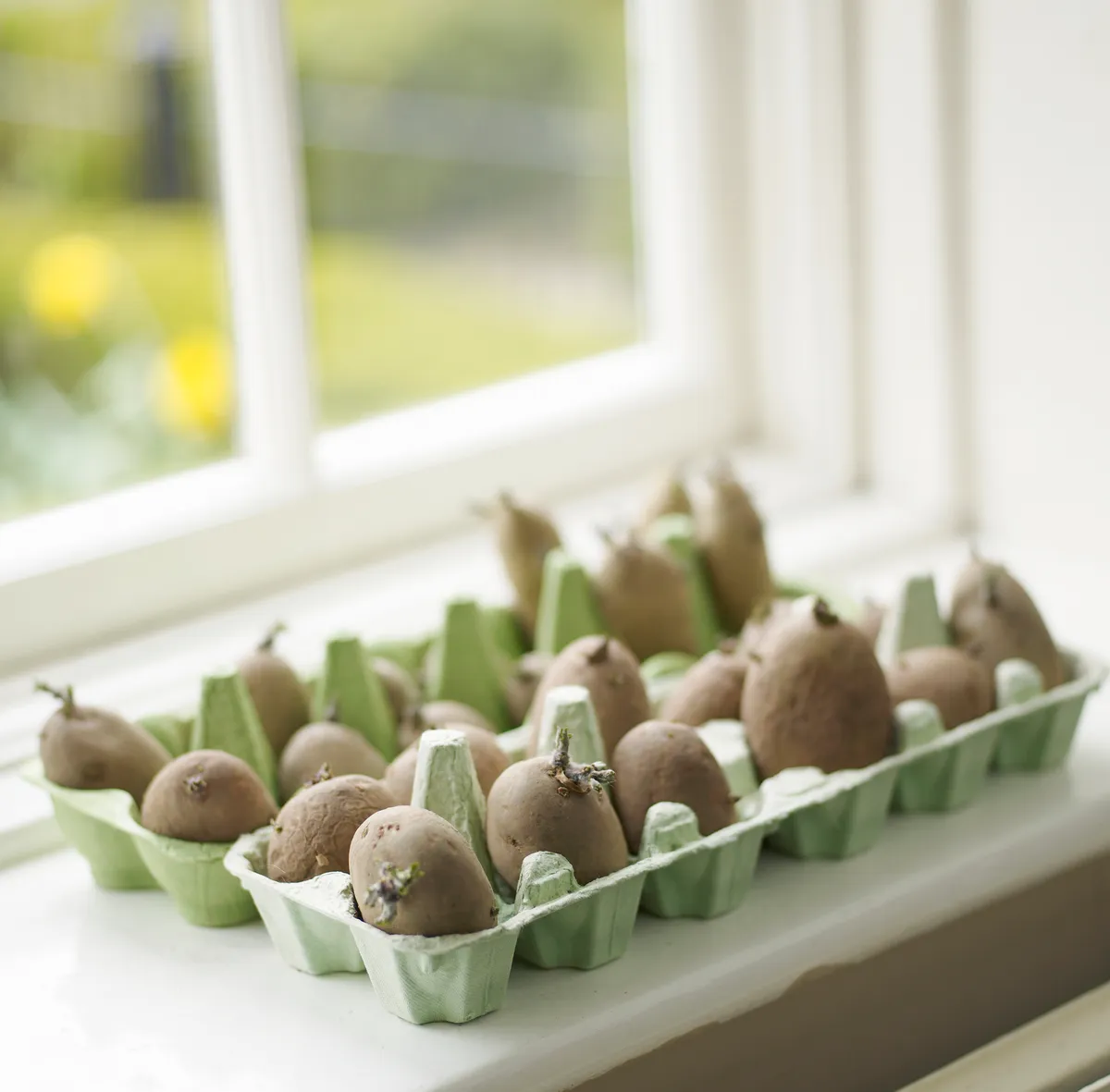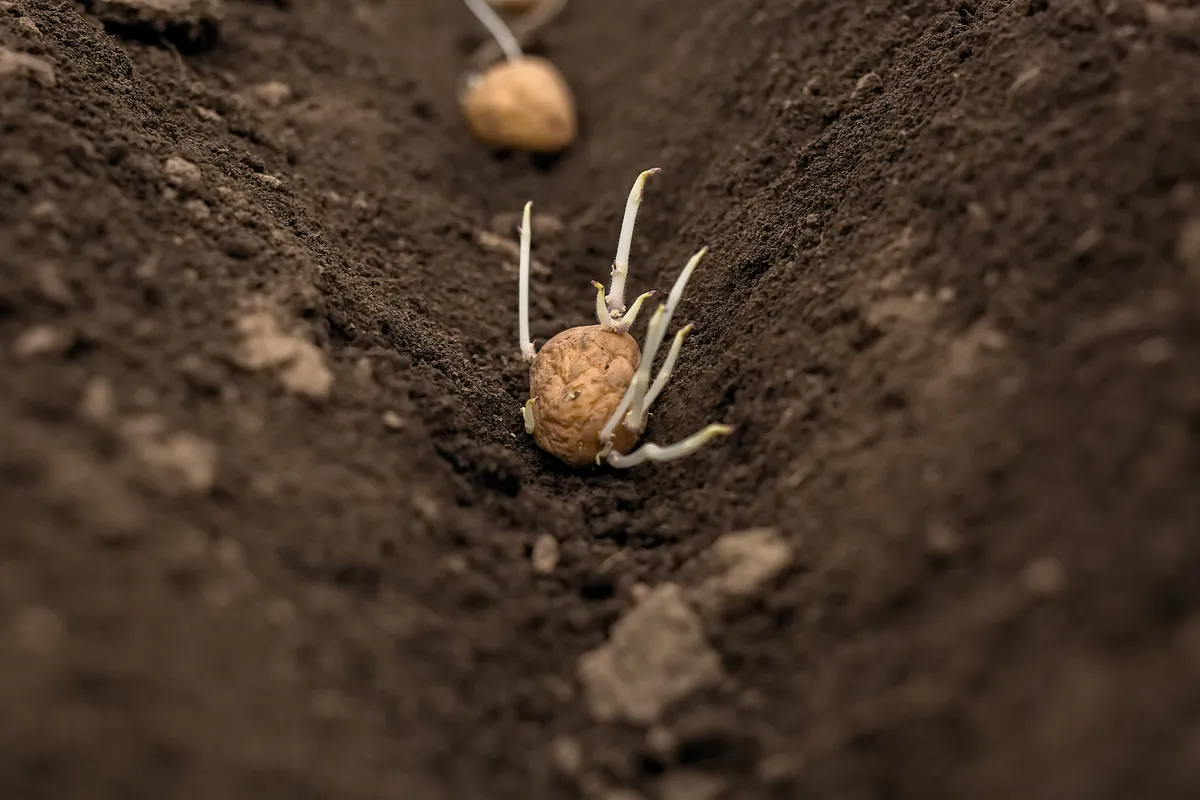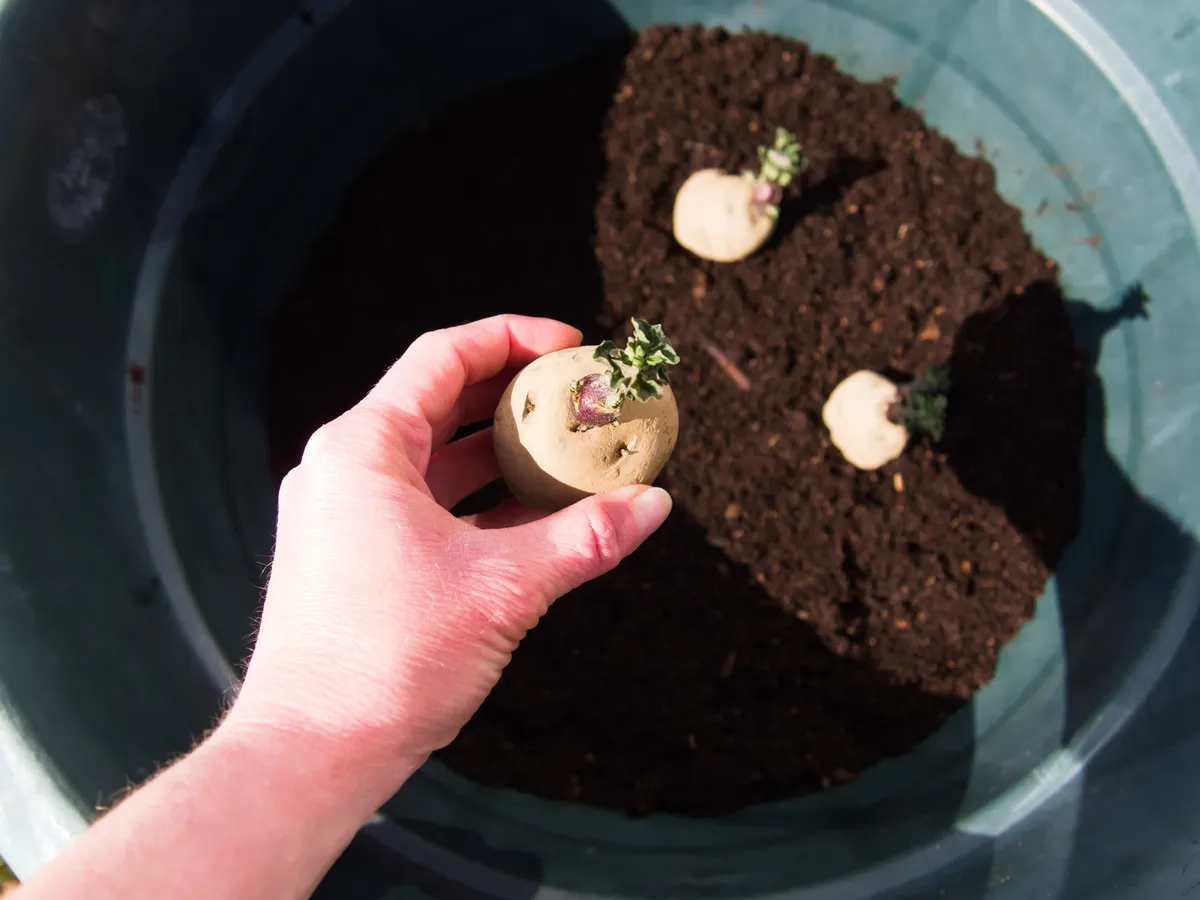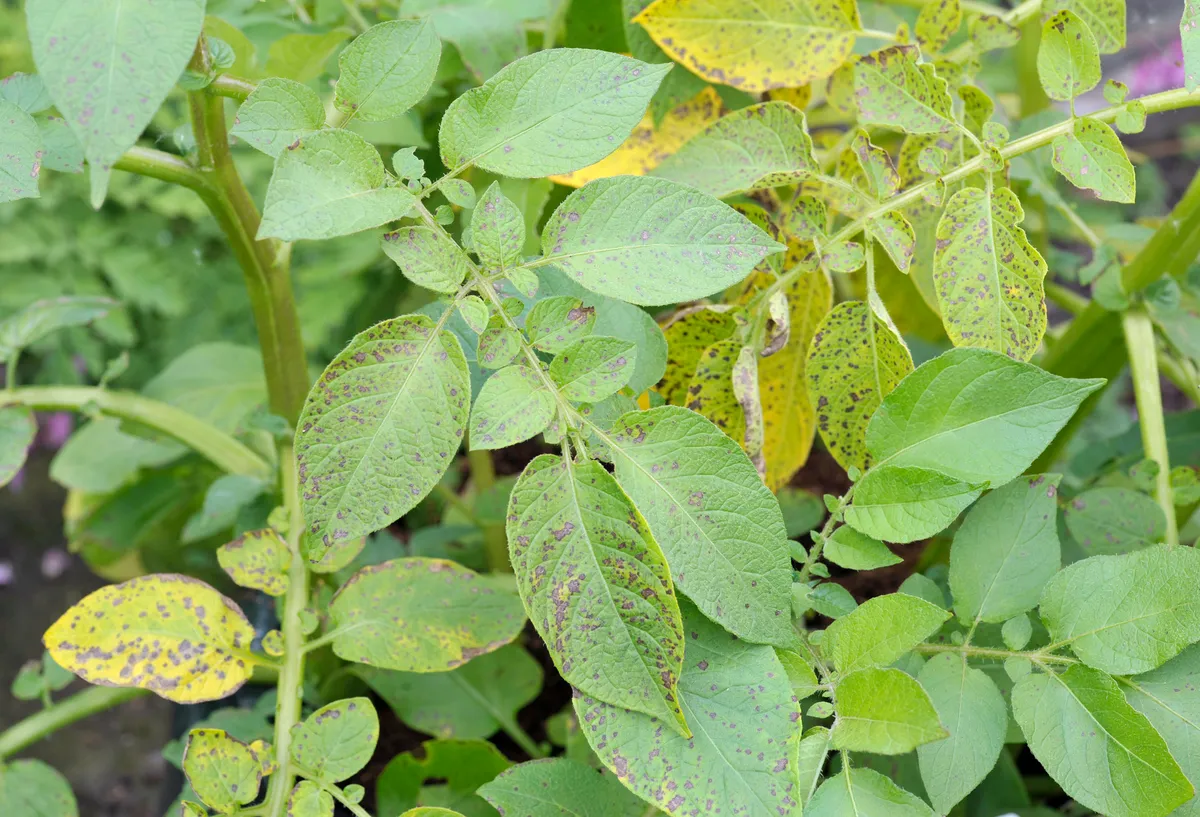The potato’s ubiquitous role in so many cuisines around the world is down to its easygoing nature. No other food group is so cheap and nutritious, yet can be grown in such small spaces. It can be stored, easily transported and cooked quickly. Chitting potatoes is the first thing you need to do if you're growing your own. The dull days of winter lend themselves to this job, and we all do it.
Here's more on growing vegetables in pots.
Jump to
- What is chitting potatoes?
- When to start chitting potatoes
- How do you chit potatoes?
- How to choose your potatoes
- When to plant out your chitted potatoes
- How far apart should I plant potatoes?
- Earthing up potatoes: what is it and why do we need to do it?
- Growing potatoes in a container
- When to harvest potatoes
- What is potato blight and how to avoid it?
- What is potato day?
- The best potatoes to grow
Everything you need to know about chitting potatoes
What is chitting potatoes?
Chitting potatoes means encouraging the tuber to produce strong, short, stubby green shoots before planting. It's the practise of making potatoes start to sprout before planting in the soil. Chitting is supposed to help a crop mature quickly after planting. Although, let's not forget that the soil temperature when you finally plant your potatoes is what makes the most difference.

When to start chitting potatoes
You'll need start buying seed potatoes in January and allowing them to 'chit' indoors from late January through to early February.
How do you chit potatoes?
Place potato tuber upright in an egg box, in a light, airy, frost-free place such as an unheated room. If you chit your potatoes in a heated room this will speed up the process, but beware, unless your ground outside is similarly warm when you plant them, your potatoes will sulk. The worst thing you can do is to leave your potatoes somewhere warm and dark, as you’ll get long, brittle sprouts that are almost impossible to plant without damaging.

How to choose your potatoes
Seed tubers are divided into four categories based on how long they take to produce crops. First earlies are ready from June to July; second earlies from July to August; early maincrops in August; and late maincrops from September onwards. For a year-round supply of potatoes, grow all four.

When to plant out your chitted potatoes
Your chitted seed potatoes will be ready for planting in about 4-6 weeks, when the shoots are around 2cm in length. Aim to plant from early to mid-spring, as soon as the soil has warmed up to about 6°C. The longer you can give your potatoes to grow, the higher the yields will be. Potatoes like rich, deep soils in open sites but aren’t terribly fussy about soil types. If you can dig in manure or compost the autumn before, all the better. Excessively heavy or wet soils are problematic. Wet conditions can affect the skin, encouraging rust spots and blight and attracting slugs.

How far apart should I plant potatoes?
Plant potatoes 10-15cm deep, either in a trench or in individual holes. First and second earlies need about 30cm between tubers and 45cm between rows. Early and late maincrops need 40cm between tubers and 70cm between rows.
Earthing up potatoes: what is it and why do we need to do it?
Once the potato foliage grows to roughly 10cm high, you need to start ‘earthing up’ by drawing soil around the leaves. This stops surface tubers from going green, helps guard against blight, improves drainage and controls weeds. Cover all but the top leaves. Keep doing so until the foliage is too high to cover.
If your soil is heavy and digging is not your thing, you can go up, or grow in pots. ‘Going up’ means simply placing the potato on the surface of the soil and covering it with compost or a layer of thick mulch such as rotted straw, very well-rotted manure or a thick layer of seaweed, which is said to improve the flavour. The only drawback to going up is that this layer of organic matter is manna to slugs, which can make mincemeat of young potato shoots and even tubers.
Growing potatoes in a container

If you don't have a vegetable plot, you can grow potatoes in a container or even a bag. There are lots of specially designed potato pots and bags available to buy, but you can use any reasonably large, deep container (50cm high or so) with good drainage, or an old compost bag (pierce holes in the bottom) with the sides rolled down. Good, rich soil or compost is best. Plant 3-5 tubers in about 25cm of compost at the bottom of the pot and gradually fill it with compost as the plant grows. As you continue to add compost, you can simply unroll your bag to allow you to fill it with more soil.
When to harvest potatoes
Wait a couple of weeks after the first flower opens, or you’ll be eating potatoes the size of your thumbnail. Yellowing foliage shows your first and second earlies are ready. With maincrops, wait until the foliage begins to die (if this hasn’t happened by the allotted time, cut it back). A fork tends to be better than a spade, as there is less risk of slicing right through a potato. There's even specific potato forks with wider, blunter tines designed for lifting potatoes out of the ground without damaging them. Leave the tubers in the ground for roughly two weeks to let the skin ‘set’ or they won’t store well. Long-term storage should be cool but frost-free, around 4 °C. Store them in the dark or they will turn green and poisonous.
What is potato blight and how to avoid it?
Potato blight is a disease that can devastate crops. Caused by the fungus Phytophthora infestans, the spores are spread easily through the air from one plant to the next, even over a distance, and can lie dormant until the right conditions occur - most commonly in July and August after a period of damp, humid weather. Brown spots on the leaves are a sure sign of this fungal disease.

If more than a third are infected, cut down all the foliage, bag it and bin it. Do not put it on your compost. Hopefully the blight will not affect the tubers. Another way to avoid blight is to only grow first and second earlies that are usually up and out of the ground by July. There are also a number of cultivars that have better blight-resistance, so check what you are buying. I have had a great deal of success with the blight-resistant ‘Sarpo’ family (see What to grow, below).
What is potato day?
Not to be confused with the international date in August, which is largely celebrating eating potatoes, Potato Day in the UK is more typically in late January or early February and involves local gathering of nurseries and horticultural societies to sell seed potatoes (also search under Seed Swap events). This is a great way to find some more unusual cultivars and chat to growers about each of their pros and cons. You can also just buy one of two tubers of your choice to try out, rather than having to buy whole bag.
The best potatoes to grow
Around 150 kinds of potatoes are available. There are two main culinary types: waxy ones and floury ones. Waxy potatoes are low in dry matter and are best boiled and used in salads. They don’t fall apart when cooked (unless you really over cook them). Floury potatoes have a higher dry matter content and are best mashed, baked, crisped or roasted. There are a fair few that sit somewhere in between. You can buy seed potatoes at local Potato Day events (dates vary, but events tend to take place in late winter), but if you want to find the rare and heritage cultivars your best bet remains the mail-order catalogue. Here are the cultivars that I’m prepared to fight over come Potato Day.
First earlies
‘Arran Pilot’ (1930, Scotland) is one of most popular garden-grown first earlies because of its cooking qualities. You get lots of very different-sized tubers, which I personally like.
‘Duke of York’ (1891, Scotland) is a very versatile, waxy yellow potato that matures quickly with a wonderful flavour.
‘Red Duke of York’ (1942, Netherlands) is a very pretty potato: impressive foliage, pink flowers and pink tubers. It stores well, has a fantastic flavour and is very versatile for cooking purposes.
Second earlies
‘British Queen’ (1894, Scotland) is having a comeback and makes an excellent masher with fantastic flavour. It does best in rich soil.
‘Charlotte’ (1981, France) is a parent to many modern hybrids and has a fantastic flavour as a salad potato; very waxy. It is prone to blight, but you can usually harvest before the disease first arrives in July.
Early maincrops
‘Belle de Fontenay’ (1885, France) is a firm favourite for its smooth, delicious, waxy tubers. It stores very well.
‘Ratte’ (1872, France) I’d actually get in a fight for this one. The ‘Ratte’ is the best-tasting potato, a little earlier than ‘Pink Fir Apple’, just as good at storing and less hassle to clean.
‘Salad Blue’ (c. 1900, Scotland) has won a place in my heart for its all-blue tubers, which are high in dry matter. Excellent for chips and roasts.
Late maincrops
‘Pink Fir Apple’ (1850, France) – I grew up on this salad potato. A wonderful nutty flavour; super-nobbly.
‘Dunbar Standard’ (1936, Scotland) is a good cooker and doesn’t mind heavy soils. A bit of a beast in size, it tends to be bothered by eelworm.
‘Sarpo Mira’ (2002, Hungary) blight and virus-resistant. If it gets blight don’t worry and don’t cut the leaves down, at least until September – if you don’t you’ll get monster floury potatoes. Alan ‘Potato’ Romans calls this cultivar ‘peasant survival food’.
‘Sarpo Axona’ (2004, Hungary) is similar to its sibling but tastes a bit better.